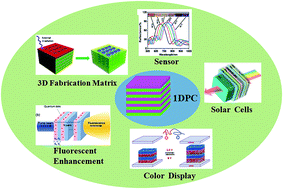One-dimensional photonic crystals: fabrication, responsiveness and emerging applications in 3D construction
Abstract
A one-dimensional photonic crystal (1DPC), which is a periodic nanostructure with a refractive index distribution along one direction, has been widely studied by scientists. In this review, materials and methods for 1DPC fabrication are summarized. Applications are listed, with a special emphasis on sensing platforms and photovoltaic devices together with full color display. After that, some typical 3D ordered structures with stacked layers are highlighted, fabrication methods are also described, and remaining problems are pointed out. Lastly, the possibility of building 3D stacked structures based on 1D layers through chemical routes is discussed; a relatively convenient and flexible method. We believe such a method is a promising way to conduct 3D fabrication.


 Please wait while we load your content...
Please wait while we load your content...